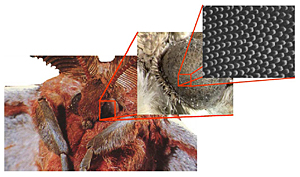
ADVERTISEMENT
- Rozovsky wins prestigious NSF Early Career Award
- UD students meet alumni, experience 'closing bell' at NYSE
- Newark Police seek assistance in identifying suspects in robbery
- Rivlin says bipartisan budget action, stronger budget rules key to reversing debt
- Stink bugs shouldn't pose problem until late summer
- Gao to honor Placido Domingo in Washington performance
- Adopt-A-Highway project keeps Lewes road clean
- WVUD's Radiothon fundraiser runs April 1-10
- W.D. Snodgrass Symposium to honor Pulitzer winner
- New guide helps cancer patients manage symptoms
- UD in the News, March 25, 2011
- For the Record, March 25, 2011
- Public opinion expert discusses world views of U.S. in Global Agenda series
- Congressional delegation, dean laud Center for Community Research and Service program
- Center for Political Communication sets symposium on politics, entertainment
- Students work to raise funds, awareness of domestic violence
- Equestrian team wins regional championship in Western riding
- Markell, Harker stress importance of agriculture to Delaware's economy
- Carol A. Ammon MBA Case Competition winners announced
- Prof presents blood-clotting studies at Gordon Research Conference
- Sexual Assault Awareness Month events, programs announced
- Stay connected with Sea Grant, CEOE e-newsletter
- A message to UD regarding the tragedy in Japan
- More News >>
- March 31-May 14: REP stages Neil Simon's 'The Good Doctor'
- April 2: Newark plans annual 'wine and dine'
- April 5: Expert perspective on U.S. health care
- April 5: Comedian Ace Guillen to visit Scrounge
- April 6, May 4: School of Nursing sponsors research lecture series
- April 6-May 4: Confucius Institute presents Chinese Film Series on Wednesdays
- April 6: IPCC's Pachauri to discuss sustainable development in DENIN Dialogue Series
- April 7: 'WVUDstock' radiothon concert announced
- April 8: English Language Institute presents 'Arts in Translation'
- April 9: Green and Healthy Living Expo planned at The Bob
- April 9: Center for Political Communication to host Onion editor
- April 10: Alumni Easter Egg-stravaganza planned
- April 11: CDS session to focus on visual assistive technologies
- April 12: T.J. Stiles to speak at UDLA annual dinner
- April 15, 16: Annual UD push lawnmower tune-up scheduled
- April 15, 16: Master Players series presents iMusic 4, China Magpie
- April 15, 16: Delaware Symphony, UD chorus to perform Mahler work
- April 18: Former NFL Coach Bill Cowher featured in UD Speaks
- April 21-24: Sesame Street Live brings Elmo and friends to The Bob
- April 30: Save the date for Ag Day 2011 at UD
- April 30: Symposium to consider 'Frontiers at the Chemistry-Biology Interface'
- April 30-May 1: Relay for Life set at Delaware Field House
- May 4: Delaware Membrane Protein Symposium announced
- May 5: Northwestern University's Leon Keer to deliver Kerr lecture
- May 7: Women's volleyball team to host second annual Spring Fling
- Through May 3: SPPA announces speakers for 10th annual lecture series
- Through May 4: Global Agenda sees U.S. through others' eyes; World Bank president to speak
- Through May 4: 'Research on Race, Ethnicity, Culture' topic of series
- Through May 9: Black American Studies announces lecture series
- Through May 11: 'Challenges in Jewish Culture' lecture series announced
- Through May 11: Area Studies research featured in speaker series
- Through June 5: 'Andy Warhol: Behind the Camera' on view in Old College Gallery
- Through July 15: 'Bodyscapes' on view at Mechanical Hall Gallery
- More What's Happening >>
- UD calendar >>
- Middle States evaluation team on campus April 5
- Phipps named HR Liaison of the Quarter
- Senior wins iPad for participating in assessment study
- April 19: Procurement Services schedules information sessions
- UD Bookstore announces spring break hours
- HealthyU Wellness Program encourages employees to 'Step into Spring'
- April 8-29: Faculty roundtable series considers student engagement
- GRE is changing; learn more at April 15 info session
- April 30: UD Evening with Blue Rocks set for employees
- Morris Library to be open 24/7 during final exams
- More Campus FYI >>
10:22 a.m., March 7, 2011----If you look closely at the surface of a moth's cornea, you see that it is comprised of tiny protruding bumps. These bumps exist to keep moths safe from predators by preventing light from reflecting in their eyes and betraying their presence. In essence, the moth's eyes are naturally antireflective.
Antireflective (AR) surfaces are commonly used to prevent glare in optics -- think of the thin film coating applied to the lens of your favorite glasses.
In a unique application, Mark Mirotznik, associate professor in the Department of Electrical and Computer Engineering at the University of Delaware, has adapted these AR ideas and applied them to materials at microwave frequencies.
Advances in passive imaging at millimeter wave frequencies have created a need for high quality optical components, such as lenses, designed specifically for these wavelength bands, explains Mirotznik.
Broadband AR surfaces are commonly implemented by coating the surface with multiple layers of thin films, with the exact number and thickness of layers needed determined by various optimization algorithms.
The approach is tricky when using microwave and millimeter wavelengths, however, because suitable materials are scarce and signal strength is commonly many orders of magnitude smaller than that encountered in the visible or infrared wavelengths.
Inspired by the subwavelength surface pattern of the cornea in common insects, Mirotznik has developed an inverse motheye surface that is easier to fabricate than traditional motheye surfaces, more mechanically robust and provides good AR behavior.
The main application for this research is to create radio frequency (RF) transparent windows, most likely using composite materials, for use in military applications.
“We've demonstrated that it is possible to use a moth eye approach to create special surfaces in which microwave energy is transmitted with very little reflections over large ranges of frequency or bandwidths,” he says.
“Expensive antenna systems can then be placed behind the structural windows, safe from the outside environment, or in the case of military applications, from hazards such as gun fire or explosives.”
Mirotznik's research is documented in a paper entitled “Broadband Antireflective Properties of Inverse Motheye Surfaces.” The paper, which appeared in the IEEE journal Transactions on Antennas and Propagation, recently earned Mirotznik the 2011 H.A. Wheeler Prize Paper award. The H. A. Wheeler Prize is presented to authors of the best applications paper published in the IEEE Transactions on Antennas and Propagation during the previous year.
Co-authors for the paper include UD doctoral student Brandon L. Good, one of two researchers at Carderock Division of the Naval Surface Warfare Center; and two researchers from the U.S. Army Research Laboratory.
Miroztnik will accept the award, given annually by the IEEE's Antennas and Propagation Society, at the society's annual meeting to be held in July in Spokane, Wash.
Article by Karen B. Roberts
Photo by Ambre Alexander



